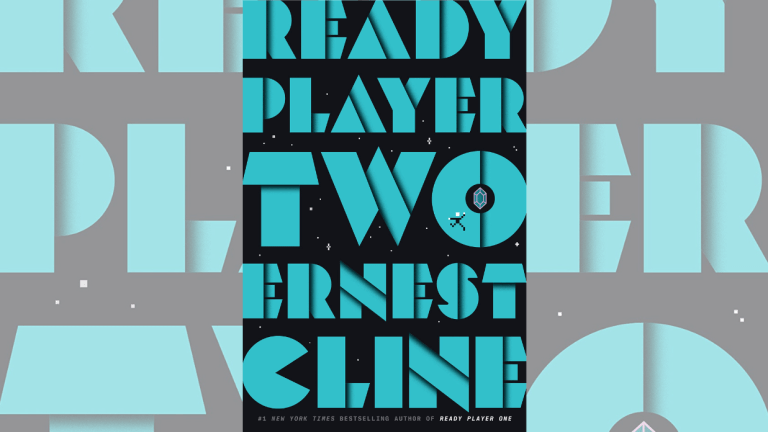Ready Player Two Review: Ernest Cline’s Soulless Sequel Beats a Dead Horse
The Ready Player One sequel sets out to explore the ethics of escapism, but fails its own quest.

It doesn’t take long for Ernest Cline’s Ready Player Two to reunite gunter-turned-billionaire Wade Owen Watts with a vintage video game that holds a clue to a virtual scavenger hunt that will forever change the future of the digital, escapist OASIS. But after winning this particular game, Parzival (Wade’s OASIS alter ego) finds that he automatically starts over. Because of an extra life, he is given the option of playing through the game again, even though there are no surprises, simply to rack up extra points and because he can.
Reading Ready Player Two feels a lot like that. Ready Player One, Cline’s 2011 debut novel, delighted readers with its futuristic generation of gunters who had taken on all things 1980s with religious fervor in search of the Easter egg that would bequeath the OASIS, Willy Wonka-style, to one lucky player. The book also made some incisive commentary on retreating into digital worlds instead of trying to fix the climate change-ravaged Earth. But neither of these is reason enough to warrant a sequel, especially one that effectively tries to play through the same plot of a posthumous quest with double the pop culture name-dropping and world-ending stakes.
This time around, Wade is rich beyond his wildest dreams but basically a friendless recluse, and now the OASIS can give you a full-senses experience but can also potentially kill you. Turns out that in addition to winning James Halliday’s fortune, Wade inherited one more thing: the OASIS Neural Interface, or ONI, which allows users to experience every touch, taste, and smell of their digital world. Pop culture aficionado that he is, Wade ponders how easily the ONI could be used for evil—and then decides to release it to his fellow OASIS users anyway, justifying it with the reasoning that he could never withhold wholly immersive escapism from the miserable masses.
Wade relates all this in a bevy of early chapters that jump ahead three years, smoothing out key emotional moments and massive changes to the book’s universe into an unemotional narrative blur—ironic, considering that the whole point of the ONI is that it allows people to feel like never before. I’ve read Wikipedia summaries with more feeling than the beginning of this book. By the time the main plot begins to unfold, readers will feel so distant from Wade that it will be difficult to care when his actions resurrect a ghost in the machine, sending Parzival and the rest of the “High Five”—his strained besties and business partners including Aech, Shoto, and ex-girlfriend Samantha a.k.a. Art3mis—on a muddled fantasy quest with a ticking clock. This time, when you die in the game, you actually die IRL (or, as the kiddos call it in 2048, the Earl—sigh).
Instead of three keys to three gates, it’s Seven Shards to the Siren’s Soul, which gives the book more of a fantasy quest feel than Ready Player One’s video game tournament vibe. Of course, that doesn’t preclude Wade from the aforementioned arcade visit, nor another batch of Halliday-approved ’80s references. The gunters’ single-minded ’80s obsession felt like clever commentary in Ready Player One; in the sequel, it verges on self-parody. It did not seem possible that Cline could find new pop culture trivia to shoehorn into these pages, and yet he does—sometimes a dozen to a single page, if we have the misfortune of encountering a character rattling off lists of movies or songs. The book’s first riddle combines Max Headroom, The Hitchhiker’s Guide to the Galaxy, and Tommy Tutone’s earworm “867-5309/Jenny,” so that should give you an idea of what you’re in for.
To be fair, Cline leans more into mashups this time around, likely following the conventional wisdom that the best way to make two familiar pieces new is to combine them. One notable excursion is the OASIS planet created in the image of John Hughes’ favorite fictional town of Shermer, Illinois. On this medley world, five different Molly Ringwalds all attend the same high school, and obscure knowledge of actors almost cast in iconic roles saves the day. The sequel also utilizes needle drops, with Parzival and his friends’ actions triggering music cues in Shermer as well as on a certain purple-themed musical world. The faithful listing of every song title and/or key lyrics reads a bit ponderous on the page, but no doubt the effect will be more fun in the inevitable Ready Player Two movie.
These interludes also have Parzival getting schooled by Art3mis and Aech for the gaps in his knowledge, for following Halliday’s broad-yet-narrow tastes and inheriting the man’s blind spots for pop culture that might have been more significant for women and people of color. It’s a different kind of self-awareness than existed in Ready Player One, but it feels more performative than anything else because it still comes from the perspective of a white man.
Ready Player One was published in 2011, and our world has changed a lot in the intervening decade, from the rise of social media influencers to gender fluidity (and its vocabulary and presentation) becoming more mainstream. One gets the sense that Cline took these cultural shifts into account when returning to the 2040s, retconning them into his speculative future. The ONI-net, in which OASIS users can experience the lives of celebrities and thrill-seekers through immersive viral clips, brings to mind Instagram and TikTok. Though there are some references to global pandemics, COVID-19 seems not to have made the cut (likely due to Ready Player Two’s publishing schedule). Nonbinary people exist in the OASIS and IRL, and one of the new supporting characters is trans, though the reader mostly experiences this through Wade’s own journey of acknowledging his own sexual confusion. Wade has become more woke, but he mostly proclaims such wokeness instead of actually acting on it.
The Wade of Ready Player One has a clear rags-to-riches story, as his obsession with a bygone decade literally pays off and transforms his life. Ready Player Two’s reverse narrative is not nearly as compelling, and falls into the trap of altering its characters’ circumstances without actually depicting character growth. Aech, Art3mis, and Shoto go through major life changes yet somehow get even less plot development than the first time around. That trans character gets shuffled off to a side quest that will no doubt become its own tie-in novella, when it would have been more affirming for her to be front-and-center—the new Parzival, eager to crack the puzzle. None of these characters are elevated from supporting cast to Wade’s crisis of conscience. Unlike the OASIS, the world of these books remains static and unchanging.
Rather than extend that extra life through another run-through of the same game, Wade wisely lets it expire and takes his win. If only Cline had done the same.
Ready Player Two is available now from Ballantine Books.
